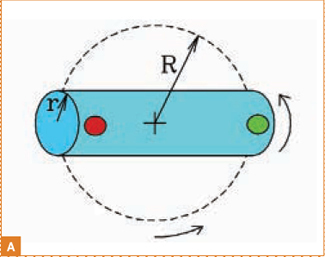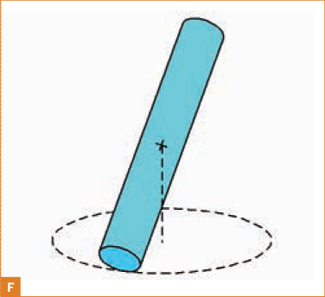TOYS, TRICKS, & TEASERS
The Spinning Cylinder Illusion
This is a toy, a puzzle, and an illusion all in one, with only one moving part. No batteries are required. I like simplicity, especially when it produces puzzling complexity.
I’ve not been able to track down the origin of this homemade toy, but it isn’t very well known outside the community of physics teachers. It’s a kinetic illusion, one that depends on physical motion to make you see something that isn’t there.
A familiar example of a kinetic illusion is the strobe effect sometimes seen in old movies, causing the spokes of a carriage wheel to seem to be turning in the wrong direction.
In its simplest form, this toy consists of a hollow cylinder of rigid plastic. The version in these photos is 4cm long and 1cm in diameter, with 2mm wall thickness. It was cut from a piece of polyethylene plastic tubing that happened to be lying on my workbench. Whatever tubing you use, be sure to choose a very straight piece.
This material can be cut easily with a single-edged razor blade, scrap of board, and hammer. Use heavy gloves and goggles in case the razor blade breaks. Or use a hacksaw, then smooth up the cut with fine sandpaper. Cut the piece initially a bit long, then shorten it to optimum length by trial. I’ve made small ones in 2-, 3-, 4-, and 5cm lengths. I’ve also made them from the barrels of old ballpoint pens, and larger ones from PVC plumbing pipe.
Glue or paint a red dot near one end and a green dot at the other end, or use a felt-tip marker to make distinctive symbols at the ends.
The Vanishing Dot
Place the cylinder on a flat surface. It’s best to choose a surface that won’t dent or scratch, like a smooth, hard floor. Press down on 1 side of 1 end with your thumb, as shown in Figure B, until the cylinder slips away from your thumb and flies off spinning. It will settle down, revolving about its midpoint and at the same time spinning about its long axis (Figure A).
WHERE DID THE GREEN DOT GO? Fig. A: The spinning cylinder revolves around its midpoint (radius R) and simultaneously around its long axis (radius r).
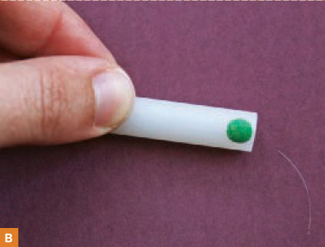
Fig. B: A small plastic cylinder has a red dot on one end, and a green dot on the other.
Here’s a sequence of photos showing the cylinder beginning to spin (Figure C), not quite settled down (Figure D), and finally spinning in one place with nearly constant angular speed (Figure E). These photos were taken with a digital camera, but they show approximately what appears to the eye.

Fig. C: Immediately after spinning, the motion is chaotic.
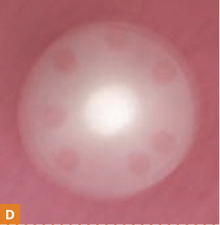
Fig. D: As the cylinder stabilizes, many red dots are visible.

Fig. E: When the spinning has stabilized, 4 red dots are clearly visible. The green dot is not visible.
Photography by Sam Murphy; illustrations by Donald Simanek
All these photos are taken from the same camera position and distance, and reproduced at constant scale. Therefore lengths on the pictures may be directly compared. Notice that a stable illusion showing 4 equally spaced dots occurs when the cylinder rotates about its center, and both ends traverse the same circle, which has a diameter equal to the length of the cylinder.
The puzzling outcome is that when the cylinder settles down to a uniform spin rate at a particular location on the table, you see only one color dot (red, in this case), repeated N times, where N is the ratio of the cylinder’s length to its diameter.
The dot you see is the one at the end you pressed with your thumb to launch it. You don’t see any evidence of the dot at the other end (green, in this case). Launch the cylinder by pressing the green dot end and then you see only the green dot, and not the red one.
How can we explain this unexpected behavior? Note that translational motion of the cylinder’s center of mass stops just before stable dot patterns become visible. Note also that what we call the “stable motion” occurs when the ends of the cylinder trace a circle.
When you think you’ve got it figured out, test your understanding by considering this follow-up question. If you spin this toy on a glass sheet, and someone looks up at it from below the glass, which colored dot would that observer see? A glasstopped coffee table is good for this experiment.
What would be the optimum length-to-diameter ratio for a given number of dot repetitions, if you used a solid cylinder? (It may not be the same.) What role does moment of inertia play here? Friction? Energy? There’s a lot of physics here to address, and it may not be easy to do.
Some Curious Observations
A 3:1 version with ¾" PVC pipe works best for the following experiments. This larger version also seems to exhibit less translational motion from the point of launch before stabilizing, enabling you to do the experiments on a smaller surface area.
Spin the 3:1 cylinder by launching it forcefully at the red dot end, and observe it from the side. For a while, it spins with the red dot end rather high in the air. During that time you may see a brief but stable pattern of 5 red dots. The cylinder’s spin slows until its red dot end is only slightly above the table. Then you see a pattern of 3 red dots for a longer time. During the transition you do not observe a stable pattern of 4 dots, except perhaps fleetingly. Why 5 and not 4? Could it be that the lower end is still sliding on the floor? This would be consistent with the observed shorter time that this motion is stable.
Solution
Another thing I like about this toy is that it combines physics and physiology. Initially, because of the manner of launching, the cylinder spins about its own long axis and slides on the floor (Figure F, next page). Because the end you launched (red dot) is also propelled sideways, the other end (green dot) drags on the floor. The friction with the floor slows the cylinder’s motion and also changes its direction.
Fig. F: As the cylinder spins about its long axis, it traces a circle around the floor. When the green dot is up, the dot is moving too rapidly to be distinctly seen. The red dot moves most slowly when it is facing upward, and is therefore briefly visible, as seen from above.
The motion stabilizes with both ends moving around a common circle, but the end you launched is not quite touching the floor, while the other end is rolling around the circle without slipping. When the green dot is up, the dot is moving too rapidly to be distinctly seen. When the red dot is up, it’s moving around the cylinder’s long axis in the opposite direction to the direction that end of the cylinder moves around the larger circle. Therefore the red dot moves most slowly when it’s facing upward, and is therefore briefly visible, as seen from above.
If the cylinder is 4 times as long as its diameter, the larger circle is 4 times the diameter of the cylinder. When rolling without slipping is established, the cylinder rotates about its long axis 4 times for every time it spins around the large circle, and therefore we see the red dot 4 times.
When the cylinder is spun very forcefully, it may for a short while spin with the cylinder elevated at a large angle, but it soon settles down to the motion described. There’s a lot of good physics going on here, involving moments of inertia, gyroscopic motion, rotational energy, and so forth. If anyone wants to work that out, please get in touch with me at [email protected], and I might find space for your analysis on my web page.
More Illusory Fun
Now that you understand the principle, you can get creatively arty. If you use a larger-sized white plastic tube, you can decorate it in various ways so that when it’s spun, it will produce “kaleidoscopic” patterns (Figure G). Star patterns are easy. Colored flexible plastic tape is good for initial experimentation (Figure H), and more permanent marking may be used later.
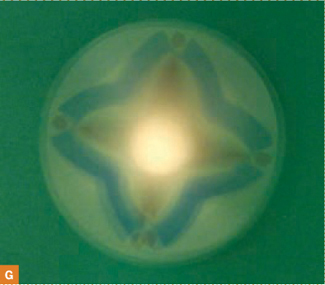
Fig. G: Different decorations can produce kaleidoscopic patterns.

Fig. H: Experiment with patterns using colored tape.
Photography and illustration by Donald Simanek
Donald Simanek is emeritus professor of physics at Lock Haven University of Pennsylvania. He writes about science, pseudoscience, and humor at www.lhup.edu/~dsimanek.
The Electronic Frontier Foundation (EFF) is the leading organization defending civil liberties in the digital world. We defend free speech on the Internet, fight illegal surveillance, promote the rights of innovators to develop new digital technologies, and work to ensure that the rights and freedoms we enjoy are enhanced — rather than eroded — as our use of technology grows.
PRIVACY |
EFF has filed two major lawsuits — one against the government and one against AT&T — challenging the NSA’s illegal warrantless wiretapping program. eff.org/nsa |
FREE SPEECH |
EFF’s Coders’ Rights Project is defending the rights of programmers and security researchers to publish their findings without fear of legal challenges. eff.org/freespeech |
INNOVATION |
EFF’s Patent Busting Project challenges overbroad patents that threaten technological innovation. eff.org/patent |
FAIR USE |
EFF is fighting prohibitive standards that would take away your right to receive and use over-the-air television broadcasts any way you choose. eff.org/IP/fairuse |
TRANSPARENCY |
EFF has developed the Switzerland Network Testing Tool to give individuals the tools to test for covert traffic filtering. eff.org/transparency |
INTERNATIONAL |
EFF is working to ensure that international treaties do not restrict our free speech, privacy or digital consumer rights. eff.org/global |



